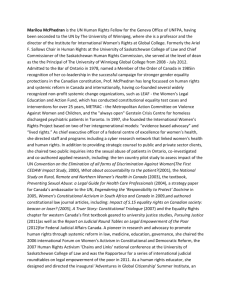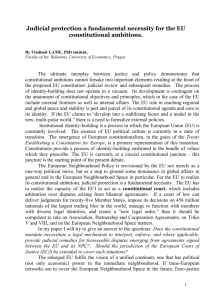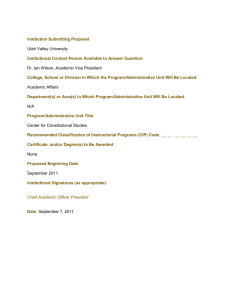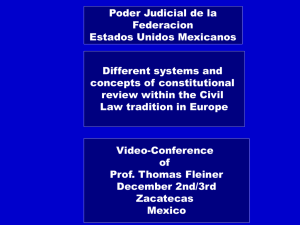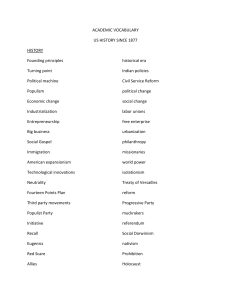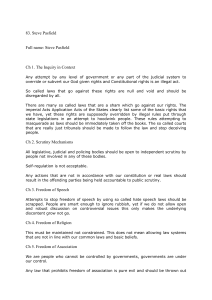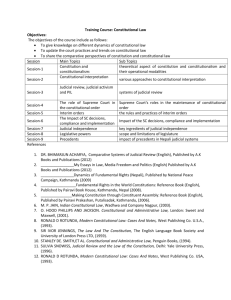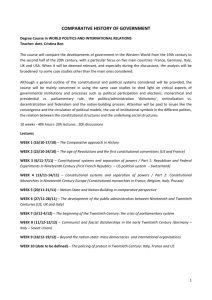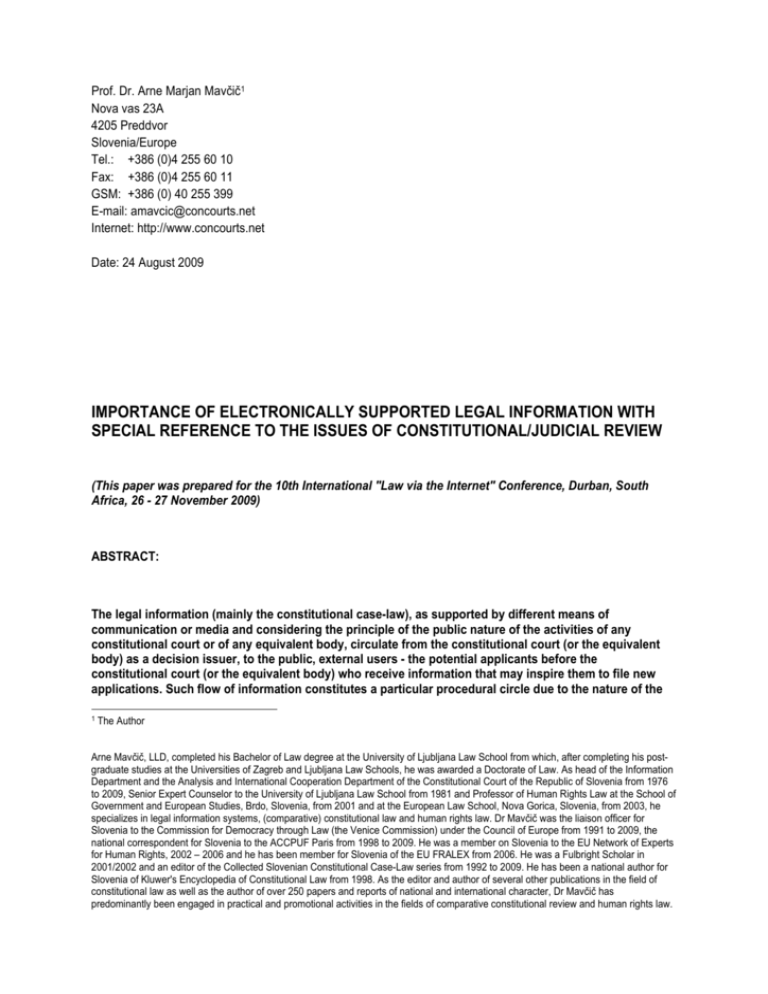
Prof. Dr. Arne Marjan Mavčič1
Nova vas 23A
4205 Preddvor
Slovenia/Europe
Tel.: +386 (0)4 255 60 10
Fax: +386 (0)4 255 60 11
GSM: +386 (0) 40 255 399
E-mail: amavcic@concourts.net
Internet: http://www.concourts.net
Date: 24 August 2009
IMPORTANCE OF ELECTRONICALLY SUPPORTED LEGAL INFORMATION WITH
SPECIAL REFERENCE TO THE ISSUES OF CONSTITUTIONAL/JUDICIAL REVIEW
(This paper was prepared for the 10th International "Law via the Internet" Conference, Durban, South
Africa, 26 - 27 November 2009)
ABSTRACT:
The legal information (mainly the constitutional case-law), as supported by different means of
communication or media and considering the principle of the public nature of the activities of any
constitutional court or of any equivalent body, circulate from the constitutional court (or the equivalent
body) as a decision issuer, to the public, external users - the potential applicants before the
constitutional court (or the equivalent body) who receive information that may inspire them to file new
applications. Such flow of information constitutes a particular procedural circle due to the nature of the
1
The Author
Arne Mavčič, LLD, completed his Bachelor of Law degree at the University of Ljubljana Law School from which, after completing his postgraduate studies at the Universities of Zagreb and Ljubljana Law Schools, he was awarded a Doctorate of Law. As head of the Information
Department and the Analysis and International Cooperation Department of the Constitutional Court of the Republic of Slovenia from 1976
to 2009, Senior Expert Counselor to the University of Ljubljana Law School from 1981 and Professor of Human Rights Law at the School of
Government and European Studies, Brdo, Slovenia, from 2001 and at the European Law School, Nova Gorica, Slovenia, from 2003, he
specializes in legal information systems, (comparative) constitutional law and human rights law. Dr Mavčič was the liaison officer for
Slovenia to the Commission for Democracy through Law (the Venice Commission) under the Council of Europe from 1991 to 2009, the
national correspondent for Slovenia to the ACCPUF Paris from 1998 to 2009. He was a member on Slovenia to the EU Network of Experts
for Human Rights, 2002 – 2006 and he has been member for Slovenia of the EU FRALEX from 2006. He was a Fulbright Scholar in
2001/2002 and an editor of the Collected Slovenian Constitutional Case-Law series from 1992 to 2009. He has been a national author for
Slovenia of Kluwer's Encyclopedia of Constitutional Law from 1998. As the editor and author of several other publications in the field of
constitutional law as well as the author of over 250 papers and reports of national and international character, Dr Mavčič has
predominantly been engaged in practical and promotional activities in the fields of comparative constitutional review and human rights law.
2
proceedings before the constitutional court (or the equivalent body) that are in principle the proposed
proceedings (juridiccion voluntaria). Concerning the public character of the activities of constitutional
courts or equivalent bodies, only a permanent inflow of applications to the constitutional court (or the
equivalent body) actually justifies its existence and function. The constitutional case-law system should
further insure the rapid spread of constitutional and legal principles in force and should contribute to
higher legal safety. Accordingly, the collected or electronically available case-law might be interesting for
a legal expert who is in search of the constitutional case-law that might be similar to the case he is
working on, as well as for the potential applicant before the constitutional court (or the equivalent body),
or for a constitutional framer or legislator creating new legal rules, as well as for a constitutional court (or
an equivalent body) using the existing constitutional case-law and other relevant documents for
exercising the constitutional and/or the judicial review.
Additionally, the author presents his personal website that includes an overview of the systems of
constitutional and judicial review that might be of value for the theory and practice in the respective
fields of activity. Among others, the site includes a comparative constitutional analysis of the systems of
constitutional/judicial review in more than 150 countries. The author describes different models of
constitutional/judicial review and the bodies (constitutional courts or equivalent bodies) that hold this
special and exclusive decision-making power relevant for deciding in constitutional issues. It classifies
the bodies of constitutional/judicial review (constitutional courts and/or equivalent bodies) as special
bodies responsible for protecting the constitutionality, which makes them quite superior to other
branches of power. Their review quite often covers such legislative acts that are the highest legal
instruments of a specific legal and political system. This grants to any body of constitutional/judicial
review (a constitutional court and/or an equivalent body) a special status with the power to exercise the
constitutional/judicial review involving the separation of powers, especially in relation to the legislative
power whereby it may even annul the statutes adopted by the legislative body.
CONTENTS:
1. Significance of (Comparative) Constitutional Case-Law Information for the Activities of the Constitutional
Court (or the Equivalent Body)
2. Slovenian Official Chronicle – Former Experiences of the Constitutional Court of the Republic of Slovenia
3. Public Control / Public Nature of the Court’s Activities
3.1 Public Hearings
3.2 Publication of Court Decisions in Official Gazettes, Official Digests as well as in Legal Journals
4. Independence and Autonomy of the Organization of the Constitutional Court
5. Use of the Codices Standards
6. Private Special Website of Comparative Constitutional and Judicial Review
7. References
1. SIGNIFICANCE OF (COMPARATIVE) CONSTITUTIONAL CASE-LAW INFORMATION FOR THE
ACTIVITIES OF THE CONSTITUTIONAL COURT (OR THE EQUIVALENT BODY)
Limiting myself to the issues regarding constitutional courts or equivalent bodies I would like to emphasize that
the universal participation of constitutional courts or equivalent bodies in the modern information exchange
brought about a very important change, in particular because, generally speaking, until 1990 legal informatics in
3
constitutional matters in Europe, with a few exceptions2, did not keep up with general trends in other domains. In
many cases the documents issued by constitutional courts or equivalent bodies (mainly case-law) used to be
processed by other subjects, at that time more advanced in informatics.
On these grounds the initiative by the then founded Venice Commission of the Council of Europe3, welcome from
the very beginning, resulted in the fact that constitutional courts and equivalent bodies exercising
constitutional/judicial review under a common information (documentation) centre would enable their potential
users to access the information on the matters of constitutional/judicial review. Nowadays, the bulk of legal
information is still on the increase, which entails more troubles in orientation within one's own and other legal
systems. In this situation the solutions providing appropriate professional comparative exchange of information as
well as comparative studies on the matters of constitutional/judicial review are very welcome.
At this point we should recall the respective first attempts from a long time ago when such very concrete project
was explained on the occasion of the Seventh Conference of European Constitutional Courts, held in Lisbon from
27 to 29 April 1987. It was a progressive and visionary joint project of the then Italian and German constitutional
courts that aimed at the concentration of comparative constitutional case-law available for constitutional courts
and equivalent bodies exercising constitutional/judicial review as well as for other users, located at the University
of Bologna4. Unfortunately, this project was not well understood by the Conference participants and was
accordingly not realized at that time5.
From the point of view of the application of the constitutional case-law, the documents shall be collected as full
texts, possibly without selection. The selection shall always be subject to the envisaged application: in principle,
the producer (author) of the documents is the only one authorized to it. The selection shall always be sufficiently
representative. The user's interest shall always be taken into account. In my opinion, the information process is
optimum when the user does not have the data served by the producer but is free to select them.
Concerning the Slovenian Constitutional Court practice, the following types of information are necessary for any
form of comparative constitutional-law issues:
-
Constitutional case-law;
General opinions or reports taken by constitutional courts or by equivalent bodies;
Theory on constitutional/judicial review;
Regulations on constitutional/judicial review matters (provisions of the Constitution, laws on
constitutional courts or equivalent bodies with similar competence, rules of procedure and other internal
regulations of constitutional courts and equivalent bodies exercising constitutional review etc.).
The exchange of this type of information should further provide for more fast spreading of legal principles in force
2
E.g., the Italian legal database designed by the Italian Supreme Court (Corte Suprema di Cassazione); the German legal information
system JURIS; the Austrian legal information system ALEXIS.
3
The real opportunity has opened the first ad hoc Commission of the Conference from 31 March 1 April 1989 in Venice, convened by the
Italian government with the participation of the then Member States of the Council of Europe Conference by Dr. La Pergola. On the
following ad hoc conference on establishment of the Commission from 19 to 20 January 1990 in Venice, held at the invitation of the Italian
government, the resolution establishing the Commission for a transitional period of two years, was adopted the European Ministers for
Foreign Affairs of the then Council of Europe Member States. At the same conference were present as observers the following countries:
Bulgaria, Czechoslovakia, German Democratic Republic, Hungary, Poland, Romania, Yugoslavia and the Soviet Union. The Commission
obtained an autonomous and sui generis status within the Council of Europe and the Secretariat as a technical support. In accordance with
arrangements by the then Italian Government and the Venetian Region (Regione Veneto), in terms of organizational and technical
reasons, a solution was found to locate the Commission’s headquarters in Venice. Due to the place of its establishment and according to
the ordinary place of its plenary sessions, the Commission received its second, in practice more familiar name - the Venice Commission.
4
The initiators of the idea were then President of the Federal Constitutional Court of Germany dr. Wolfgang Zeidler (1924-1987) and then
President of the Constitutional Court of Italy, dr. Antonio La Pergola (1931-2007). Information on the project was presented to participants
at the meeting of presidents of constitutional courts, the conference participants, 28 April 1987. It has been suggested that in (the oldest
European University) University of Bologna organized by the International Documentation Center on the Constitutional Court related to the
system for the computerized data processing. Bologna should mean the best location in terms of traditions and geographical links.
5
At this meeting, presented the idea drew out attention. Since it has been defined as a formal proposal, it did not decide. They have
provided support for the establishment of the center, but with a clear margin on specific funding opportunities. Perhaps it was then time for
the idea too ambitious and too early, so that the debate on the slide in the dead end because of alleged problems with the future funding of
such institutionalized useful information and links regarding its seat.
4
and it should contribute to higher legal safety. In compliance with such concept, each individual document might
be interesting for a wide range of external users, i.e. regarding the contents of a definite decision of the
constitutional court (or the equivalent body) or the contents of any other text from the practice and theory of
constitutional courts and/or equivalent bodies. It could be duly anticipated from the Slovenian experience that the
final user of legal information would be less interested in more bibliographic data than in more substantial
information.
The study of the collected constitutional case-law may be of the following importance:
-
Aid to the constitutional court and/or the equivalent body activities;
Scientific contribution to the theory on constitutional/judicial review;
Historical survey of constitutional/judicial review;
Practical aid in the domain of implementation of the constitution and the law.
The information on the constitutional case-law is classified under scientific information of the vast domain of law.
This encompasses the use of specific knowledge from the domain of constitutional justice. As a matter of fact,
this area includes the information on anomalies in law6. The information on the practice of constitutional courts
and/or equivalent bodies is relevant for the investigation of systems of constitutional/judicial review from the
comparative point of view. On the other hand, the information in question is designed for monitoring the social
phenomena that are relevant for safeguarding the rule of the Constitution and the law and that are reflected in the
practice of the constitutional court and/or of equivalent bodies. A complex solution of any social case, however,
requires a high level of technical, scientific and research work whereby information on the attitude of the
constitutional justice might be useful as well.
2. SLOVENIAN CHRONICLE - FORMER EXPERIENCES OF THE CONSITUTIONAL COURT OF THE
REPUBLIC OF SLOVENIA
Starting with 1963, the legal information system of the then Constitutional Court of the Republic of Slovenia 7I
included the constitutional case-law of the Slovenian Constitutional Court in the uniform legal database (based on
classical records) including also the constitutional case-law of all other constitutional courts from the territory of
the former Yugoslavia. At that time the compiled data on the decisions of nine constitutional courts were,
however, an indispensable basis for their work.
Therefore, since the introduction of constitutional review in the former Yugoslavia in 19638, the then Legal
6
Which have been removing through a special procedure by decisions taken by constitutional courts or other equivalent bodies.
In the period after adoption of the Slovenian Constitution of 1991 (Official Gazette RS, No. 33/91), the Constitutional Court has played a
more important role based on its new extended powers. In the sense of contemporary trends, the Slovenian Constitutional Court has
assumed the role of a negative Legislature. In this period of transition the Legislature is not always able to follow developments nor to
impose standards for all shades of the legal system and its institutions. This results in the so-called interpretative decisions taken by the
Court or the appellative decisions or certain declaratory decisions that include certain instructions by the Constitutional Court to the
Legislature on how to settle a certain question, or a specific issue (Art. 48, Constitutional Court Act, Official Gazette RS, No. 15/94).
However, in compliance with the Principle of Judicial Self-Restraint, a clear limit has been imposed on the Slovenian Constitutional Court
due to the fact that the Court has actively been creating the legal rule both negatively (e.g. by abrogation) and positively (e.g. by
appellative, interpretative and the declarative decisions), a function theoretically reserved for the Legislature.
7
The Constitution of the Socialist Republic of Slovenia of 1963 (Official Gazette SRS, No. 10/63) envisaged the first (Federal Constituent
Republic) Constitutional Court. This Constitution was adopted at that time when the "social needs for the deepening of the self-managing
socialist democracy and additionally for more efficient protection of constitutionality and legality" appeared. In the first place, previously the
judicial review (control) of legality of administrative acts was already introduced. However, the practice showed that the legislative and
executive bodies (first of all for the objective reasons) were not able to review the constitutionality and legality of regulations enough
efficiently and critically by themselves, because they were authors of such regulations at the same time. Similarily became evident in other
countries as well. Therefore the then government decided that it would be better to introduce special, from the legislature and executive
independent state bodies which would be empowered for the protection of the constitutionality and legality of regulations – likely from the
establishment of the Austrian Constitutional Court onwards, more and more countries introduced such special constitutional courts.
8
The establishment of constitutional review was largely accredited to the support of the then political leaders, who held the review that
5
Information Centre of the Slovenian Constitutional Court was engaged in a systematic acquisition and
comparative processing of case-law of all former Yugoslav constitutional courts9. These efforts developed into
comprehensive records on the case-law of Yugoslav constitutional courts (translated into one language – into
Slovenian), organized in files. This was an excellent basis for transition to the computer processing of the
constitutional case-law. The above-mentioned database was computerized by 1 January 1987. The database
was based and maintained on the then full-text program packages of different generations and was open to the
public at many locations. The then free search database included full-text documents (covering constitutional
case-law and theory) and was subject to monthly updating.
Very early, an exchange of constitutional case-law was practiced with some neighboring constitutional courts10;
besides, in 1989 the first on-line computer communications with the then existing foreign information systems
were introduced11.
An additional goal of the then national (comparative) database(s) was to build the Court's own databases
(containing the case-law and other relevant documents), which was particularly important with reference to the
fact that national databases should, wherever possible, be included into international systems of similar
character. This was important for several reasons: it led to an exchange and comparison of experiences and
thereby to improved efficiency and quality of work. Further, more and more attention was paid to the cooperation
related to the building of foreign national and international case-law databases as well as to the improvement of
the quality and standardization of primary documents (case-law and other relevant documents).
The exchange of information between the Slovenian Constitutional Court and other similar information systems,
databases and other similar sources of legal information influenced the set-up of common standards especially
concerning the structure of the constitutional/judicial review, the powers, the organization and the procedure
before constitutional courts and/or equivalent bodies, and even the unification of some systemic legislative
solutions, especially during the transitional period of the Slovenian constitutional and legal system.
The question as to whether Slovenian constitutional case-law from the period after the adoption of the 1991
Constitution (Official Gazette RS, No. 33/91), especially in its relations to the fundamental rights and freedoms,
has adapted to or is more comparable with foreign constitutional case-law, can be answered in the sense that the
Slovenian constitutional case-law came close to the foreign case-law in its approach to fundamental rights also
due to the newly established links to the national and international legal information systems abroad. The number
of cases on human rights increased considerably. In this respect it is necessary to bear in mind that the
“frequency” of individual rights before the Constitutional Court mainly depends on what kind of problem the
appellants (who may be inspired by national and international case-law as well) place before the Constitutional
Court. The Constitutional Court now appeared as a guardian of the constitutionality and legality (see Para. 1 of
Article 1 of the Constitutional Court Act, Official Gazette RS, No. 64/07) in such a way that it decides not only on
the compliance of general legal acts with the constitutional provisions on fundamental constitutional rights (in the
sense of abstract and concrete review of general legal acts) but also on constitutional complaints12 against the
disputes and controversies in the Yugoslav society should not be resolved politically but, rather, by means of "an objective and legal
arbitration".
9
Under the Federal Constitution of 1963 and 1974 as well as under Member State Constitutions of 1963 and 1974 the power of
constitutional courts was based on the separation jurisdiction between the Federation and the Member States (6: Slovenia, Croatia,
Bosnia and Herzegovina, Serbia, Montenegro, Macedonia) constitutional courts acted with due institutional independence in compliance
with the powers specified in the constitution of the appropriate level, whereby constitutional courts were in no hierarchical relation to one
another and the Federal Constitutional Court was not an instance above other constitutional courts, nor was the member state
constitutional court an instance above provincial constitutional courts. However, the then Federal Constitutional Court was empowered to
decide on the jurisdictional disputes between constitutional courts of member states and/or autonomous provinces.
10
Constitutional Courts of Italy, Austria and Germany.
11
Such as ECHO Luxembourg, JURIS (including all CELEX bases), Germany, and ALEXIS (including RDB Austria), Germany-Austria.
12
Beside the constitutional provision that the Supreme Court is the highest Court in the State (Art. 127(1), Constitution) within the scope
of the ordinary judiciary (of course) the Constitution of 1991 extended the function of constitutional review of regulations, deciding of
jurisdictional disputes and other powers which have been exercised by the former Constitutional Court(s) from 1963 onwards by some
new powers, especially be the constitutional complaint and by the impeachment as well. By the constitutional complaint, the position of the
Constitutional Court was upgraded to the highest judicial instance for the protection of human rights and fundamental freedoms. By Art.
1(1) of the Constitutional Court Act such position was only confirmed. That means that the Constitutional Court’s decisions “control” also
the decision-making of ordinary courts regarding the protection of human rights and fundamental freedoms. From the point of view of such
6
violation of human rights and fundamental freedoms by individual acts (Item 6 of Para. 1 of Article 160 of the
Constitution; Articles 50-60 of the Constitutional Court Act).
3. PUBLIC CONTROL / PUBLIC NATURE OF THE COURT ACTIVITIES
The public nature of the activities of the Constitutional Court is explicitly declared by the Constitutional Court Act
(Para. 1 of Article 3) and by the Rules of Procedure (Articles 23 to 33, Official Gazette RS, No. 86/07). This
principle may be realized in some different forms:
3.1. Public Hearings
Save where expressly provided by statute (Article 35 etc. of the Constitutional Court Act), all Court proceedings
are conducted in public and all decisions are delivered in open Court (public nature of court hearings; public
nature of delivering decisions). These public activities function as a control or supervision of the impartibility and
legality of the decision making process.
The principle of the public nature of the activities, declared by the above-mentioned provision, is of general
importance in all kinds of proceedings; the purpose of the mentioned principle is to ensure some control on the
activities of the Court to the parties of the proceedings as well as to other citizens (the unlimited circle of
individuals). The respective function is ensured e.g. also by the legal provision on public hearings before the
Constitutional Court (Article 35 and 36 of the Constitutional Court Act). The constitutional Court may exclude the
public from a hearing or part thereof on the grounds of protecting public morals, public order, national security,
the right to privacy and personal rights (Articles 37 and 38 of the Constitutional Court Act). The public nature of
the activities of the Constitutional Court also arises from some former internal regulations or systems adopted by
the Constitutional Court13 - the then Legal Information System of the Constitutional Court introduced in 1987, the
computerized database of Slovenian Constitutional Case-Law as a public database, in principle accessible to all
users of legal information.
3.2 Publication of Court Decisions in Official Gazettes, Official Digests as well as in Legal Journals
Providing information on the decisions of the Constitutional Court to the national and foreign public is, moreover,
one of the functions following the principle of the public nature of the activities of the Constitutional Court, set forth
in laws and in other regulations14. The Constitutional Court applies this principle by publishing its decisions in
official publications (e.g. Official Gazette, see Article 69 of the Constitutional Court Act and Article 46 of the Rules
of Procedure of the Constitutional Court) and by allowing access to information on its decisions in its database,
basically in the Slovenian and in the English languages. The English translation of the Slovenian constitutional
case-law has been provided from 1992 onwards.
general orientation and taking into account the constitutional concept of the separation of powers (Art. 3, Constitution) to the legislative,
executive and judicial power and respectively the special independent position of the Constitutional Court, such principles were explicitly
settled by the introductory provisions of the Constitutional Court Act.
13 Articles 4 and 39 of the Rules of Procedure of the Constitutional Court (Official Gazette SR, No. 10/74;
- Articles 39-41 of the Regulation on Internal Office Administration of 26 May and 7 July 1977 and of 16 January 1992;
- Conclusions on the Assurance of the Public Nature of the Activities of the Constitutional Court Through the Public Media
of 13 January 1983 and 24 December 1987;
14
Article 3 of the Constitutional Court Act; Article 5, Para 2 of Article 37, Articles 6, 66 and 67 of the Rules of Procedure of the
Constitutional Court; Official Gazette RS, No. 49/98, Articles 4 through 39 of the Regulation on Internal Office Administration; Conclusions
on the Assurance of the Public Nature of the Activities of the Constitutional Court through the Public Media, adopted on 13 January 1983
and 24 December 1987.
7
Slovenian constitutional case-law has been published and offered to interested public:
In Odločbe in sklepi Ustavnega sodišča (Official Digest of the Constitutional Court; the Slovenian full text
version, including dissenting/concurring opinions, and English abstracts) since 1992;
In the Pravna Praksa (Legal Practice Journal; Slovenian abstracts, with the full-text version of the
dissenting/concurring opinions);
From 1 January 1987 to 18 July 2003 via the on-line STAIRS database (the Slovenian full text version since
1963; the English full-text version since 1992); for this purpose a special English-Slovenian glossary
containing the terms on constitutional law was created;
The only original CD-ROM containing the Slovenian Constitutional Case-Law (in Slovenian) was issued in
May 1998;
Since 1993 in the Bulletin on Constitutional Case Law of the Venice Commission of the Council of Europe
(including English and French summaries of the most important current decisions), as well as in the
CODICES database issued on CD-ROM (Slovenian and English full-text versions and summaries in English
and French), http://www.codices.coe.int; http://www.coe.fr/codices;
Since August 1995 on the Internet (Slovenian constitutional case law since 1990 (full text in Slovenian as
well as in English - http://www.us-rs.si);
Since 1998 on the homepage of the A.C.C.P.U.F. (the French Speaking Group of constitutional courts)
(http://www.accpuf.org);
Since 2000 on the website of the Ius-Info database of constitutional case-law (abstracts and full texts of
decisions) and literature (abstracts) in Slovenian from 1963 onwards (http://www.ius-software.si);
The circulation of constitutional case-law information through several computerized information systems is of the
highest importance. Legal information on constitutional/judicial review matters as supported by such different
means of communication or media, taking into consideration the principle of the public nature of the activities of
any constitutional court or equivalent body, circulate from the constitutional court or equivalent body as a decision
issuer, to the public, the potential petitioners before the constitutional court or equivalent body, who receive
information that may motivate their new petitions. This stream of information constitutes a certain procedural
circle due to the nature of the proceedings before any constitutional court or equivalent body, which are in
principle proposed proceedings (jurisdiccion voluntaria): only a permanent inflow of petitions to the constitutional
court or equivalent body actually justifies the very existence, function and activities of the constitutional court or
equivalent body15.
The initial purpose of the legal databases of the Slovenian Constitutional Court was to provide more flexible
processing of legal information, primarily constitutional case-law, as a support to the Constitutional Court in its
decision-making processes. However, the activities of the Constitutional Court are conducted in public (Article 3
of the Constitutional Court Act, Official Gazette RS, No. 15/94; Article 5 and Articles 53 to 55 of the Rules of
Procedure of the Constitutional Court, Official Gazette RS, No. 49/98). Therefore the corresponding databases
were not created for internal users only (judges and legal advisers of the Court); from the very beginning they
were intended for external users of legal information concerned with practice and theory related to the
constitutional review.
4. INDEPENDENCE AND AUTONOMY OF THE ORGANIZATION OF THE CONSTITUTIONAL COURT
15
Just a broad individual access to the constitutional review contributes to the protection of human rights and fundamental freedoms,
accelerates the democratisation of any legal order and promotes the state governed by the rule of law at the same time. Furthermore, it is
a matter of a democratic supervision over the commanding state bodies and the exclusion of contradictions from the legal order and by this
means its gradual improvement (bringing in the accordance with the constitution) as well. Accordingly, a broader individual access to the
Constitutional Court stimulates the democratisation of the legal order which citizens have an opportunity to initiate a direct and immediate
control over the legislative, executive and judicial state power. In some cases such control would certainly contradict the major will,
however just such kind of tension is surely a basic element of the constitutional democracy.
8
Most systems of constitutional/judicial review allow for the organizational autonomy of the empowered body on
the basis of the Constitution or on the basis of the Constitutional Court Act. This means they authorize the
respective constitutional/judicial review bodies to follow their own rules regarding their internal organization.
Special services of the Constitutional Courts are organized in a similar way: they consist of clerks and clerical
staff, whereby the head of special services generally holds the status of a secretary general.
The Constitutional Court of the Republic of Slovenia regulates its organization and work with its rules of
procedure and other general acts (Para 2 of Article 2 of the Constitutional Court Act). The new Rules of
Procedure were adopted on 17 September 2007 (Official Gazette RS, No. 86/07).
Concerning legal information, two special services were established as follows:
Analysis and International Cooperation Department gathers data and other information of a legal nature needed
for the work of the Legal Advisory Department, prepares comparative legal materials and analyses necessary for
the cases considered by the Constitutional Court, prepares the legal basis for the constitutional court
records, provides translations of the Constitutional Court decisions into English and is active in the field of
international cooperation (Article 17 of the Rules of Procedure).
Documentation and Information Technology Department ensures information technology support for the work of
the Constitutional Court, provides for the computer-supported operation of the Constitutional Court, keeps
constitutional court records, and performs library services required by the Constitutional Court (Article 18 of the
Rules of Procedure).
The fully computerized internal administration information system was introduced in 2005. The last larger upgrade
of the information system was initiated in 2004 and has not yet been completed. In the same year, an integrated
system was introduced that incorporated all previously separate applications and documents into the Integrated
Information and Case Management System, used by all staff of the Constitutional Court involved in the case-law
related business processes of the Constitutional Court. Furthermore, the official Court’s website www.us-rs.si
(including the free search database of constitutional case-law in Slovenian and English) is subject to frequent
updating.
Generally speaking, from the users’ perspective, the Information System of the Constitutional Court includes the
following components: integrated case management system, document assembly system (which is actually a part
of the case management system), intranet and extranet, information services, internal and external legal
databases, website, user tools (Word, Outlook, etc.), other applications (e.g. finance, human resources, etc.),
which are not essential for the legal part of the business process.
5. USE OF THE CODICES STANDARDS
From the very beginning, the Slovenian Constitutional Court has been participating in the Venice Commission
activities when as early as in September 1991, at the Venice meeting of the Working Group on Constitutional
Justice, it was decided to establish a special documentation centre to collect and disseminate constitutional caselaw of all constitutional courts and/or equivalent bodies participating in the Venice Commission16, as well as to
16
The central section of the Venice Commission is the Constitutional Judiciary, because in this field the exchange information and ideas
between the traditional and the new democracies is of the highest importance. Therefore, the Commission in 1992 decided to establish a
documentation center, to accelerate the mutual exchange of information between the constitutional courts and equivalent bodies of
constitutional and judicial review and to inform the interested public about constitutional case-law. To this purpose, the Commission
established a network of liaison officers from constitutional courts and equivalent bodies of the Commission’s member states. They
prepare the contributions of the current constitutional case-law three times a year to the Bulletin of Constitutional Case-Law and to the
database CODICES Commission (Digest of Constitutional Cases) with unique systematic thesaurus. The establishment of the Joint
Council on Constitutional Justice in 2002 has institutionalized this mentioned cooperation between the institutions of constitutional and/or
judicial and the Commission.
9
make such case-law as widely available as possible. The first Slovenian liaison officer was appointed by the
Court in 199117.
Since 1992 the Slovenian Constitutional Court has been providing not only the Slovenian but also the English
version of the Court's case-law. Additionally, the Venice systematic thesaurus translated into Slovenian18 and
extended by particular Slovenian procedural terms has been used as a basic tool for the processing of decisions
in their Slovenian and English versions. The same thesaurus has been used as an index for the purposes of the
Official Digest of the Slovenian Constitutional Court.
6. PRIVATE SPECIAL WEBSITE OF COMPARATIVE CONSTITUTIONAL AND JUDICIAL REVIEW
The interest in comparative studies of systems of constitutional/judicial review substantially increased with the
drafting of the Constitutional Court Act of 199419 . At that time it turned out necessary to implement the existing
foreign solutions and experiences. Accordingly, the author’s private website (www.concourts.net)20 was
established to provide an overview of the systems of constitutional and judicial review, which might be of value for
the theory and practice in the respective fields of activity.
The website presents a comparative constitutional analysis of the system of constitutional/judicial review in more
than 150 countries.
The author of the website describes different models of constitutional/judicial review and the equivalent bodies
that hold this special and exclusive decision-making power on constitutional matters. It classifies the
constitutional/judicial review bodies as special bodies responsible for protecting the constitutionality for which they
hold a certain legal superiority in relation to other branches of power. Their review quite often covers legislative
acts that are the highest legal instruments of a specific legal and political system. This gives the
constitutional/judicial review body a special status with the power to provide constitutional/judicial review under
the system of the separation of powers, especially in relation to the legislative power in that it may even annul
statutes adopted by the legislative body.
The site is designed in Slovenian, English, French, Spanish and Russian, partly in several other languages as
well.
There are three main blocks presented on the website: Comparisons, Lectures and Projects.
The Lectures concern different issues of the knowledge and techniques of national systems of the
constitutional/judicial review. A comparison of certain topical views could add to the analysis of sources of a
national democratic process and culture21. Accordingly, it could have direct applicative value in the search for
17
The author acted as a liaison officer and expert from 1991 to 2009.
Slovenia is the only country which translated the Thesaurus into its national language.
19
Official Gazette RS, No. 15/94.
20 Author: Prof. Dr. Arne Marjan Mavcic; Design & Programming: Edo Milavec, MV d.o.o., Postojna, Slovenia; info@concourts.net
18
The Author expresses his gratitude to Mr. Edo Milavec for his excellent and professional electronic support of the mentioned website from
the very beginning.
21
See comments such as: The Challenge of Democracy, Ninth Edition, Janda/Barry/Goldman, Chapter 14, © 2005-2008 Copyright
Cengage Learning. All Rights Reserved. http://college.cengage.com/polisci/janda/chall_dem/9e/resources/internet_exercises14.html
Professor Arne Mavcic holds several academic and government positions in the Republic of Slovenia. One of his missions is to provide a
worldview of judicial review and constitutional courts. He has set out a number of different models for judicial review, only one of which is
the American version, at www.concourts.net.
10
systemic solutions in different countries. It covers the following issues: Systems of Constitutional/Judicial Review
(English); Constitutional/Judicial Review in the Federal States (English); Organization of Constitutional Review
Bodies (Slovenian); Tables regarding several Issues of Constitutional/Judicial Review (Slovenian); Comparative
Constitutional Law in Short (Slovenian).
The Projects include:
-
some close relevant links (The Venice Commission of the Council of Europe, author’s Human Rights
Reports for Slovenia for FRALEX EU; International Constitutional Law Database in Bern);
-
some foreign research projects based on the www.concourts.net website22,
One link compares different constitutional court models by country: http://www.concourts.net/chartm.php. Another link compares different
constitutional court models by population: http://www.concourts.net/chartpo.php. How does the American model compare to each model in
terms of the number of countries in the world and the population governed by each model?
Does it surprise you that some countries still have no form of constitutional court? Which ones besides the United Kingdom lack judicial
review?
Website Analisis
Perbandingan
Mahkamah Konstitusi
www.concourts.net
Seperti yang tertulis pada halaman depan situs,
pengadministrasinya menjanjikan situs ini
akan berisi analisis komparatif dari berbagai
sistem pengujian konstitusional di lebih dari
150 negara. Sebagai sebuah situs internet
yang hanya diasuh oleh satu orang, yaitu
seorang pakar konstitusi asal Slovenia yang
bernama Arne Mavèiè, LLD. seorang Head of
the Analysis and International Cooperation
Department pada mahkamah konstitusi
Slovenia, situs ini cukup komplit, bahkan
dilengkapi dengan tabel dan diagram peta yang
interaktif. tampilan situs ini juga cukup nyaman
di mata dan mudah digunakan. Dari halaman
utama kita sudah diberikan petunjuk untuk
menuju ke tabel perbandingan sistem pengujian,
diagram, peta bahkan pada materi perkuliahan
dan biografi singkat pengasuh situs.
Tabel-tabel perbandingan pun disediakan
dalam lima bahasa, Inggris, Perancis, Slovenia,
dan Russia
Konstitusi Maya, http://www.mahkamahkonstitusi.go.id/putusan/BOOK_BMK15.pdf
22
There were several research projects inspired by the www.concourts.net website, e.g.:
The judicial review of legislation can be configured in any of a number of ways. In particular this task may be concentrated in a
constitutional court, or diffused among ordinary judges. Recent studies have shown that the design of judicial institutions can have
important legal, social, and economic consequences for a given polity. Scholars have dwelled on the reasons that lead political actors to
the choice of one model of judicial review over another, but there has been little empirical study on this choice. Here, several hypotheses
as to the circumstances that lead to the establishment of constitutional courts are tested on the basis of a data set of 128 democratic
constitutions. I find that the degree of political uncertainty facing politicians is an important predictor of whether or not a constitutional court
will be established. Submitted: July 18, 2005, Accepted: January 1, 2006 · Published: August 7, 2006; Recommended Citation: Ramos,
Francisco (2006) "The Establishment of Constitutional Courts: A Study of 128 Democratic Constitutions," Review of Law & Economics: Vol.
2 : Iss. 1, Article 6. DOI: 10.2202/1555-5879.1043
Available at: http://www.bepress.com/rle/vol2/iss1/art6
Baslar, Kemal, Anayasa Yargisinda Yeniden Yapilanma, Demokrasi Platformu, Yil 1, Sayi 2, Bahar 2005 (www.anayasa.gen.tr/baslaryenidenyapilanma.htm) , Turk Anayasa Hukuku sitesi, anayasa.gen.tr, op. 12, op. 16, op. 29, op. 59;
Solyom Laszlo, Az Alkotmany Orei (http://www.mindentudas.hu/solyomlaszlo/20050523solyom1.html?pIdx=1);
11
-
several author’s publications regarding constitutional/judicial review issues and human rights issues, in
English, Slovenian, Spanish, German, Russian, Georgian, Azeri, Arabic and Hungarian.
The most important part of the website is covered by Comparisons including:
1. Introduction describing the historical steps in the development of systems of constitutional review and the origin
of the currently existing systems (models) of constitutional/judicial review (Slovenian, English, Spanish, French,
Russian).
2. Several Statistical Charts Regarding Systems of Constitutional and Judicial Review (sorted by: Type of
Court/Countries, Type of Court/Population, Type of Model/Countries), for example:
Gerhard Casper, The Karlsruhe Republic – Keynote Address at the State Ceremony Celebrating the 50th Anniversary the Federal
Constitutional Court, German Law Journal, Vol. 2 No. 18-01 December 2001 – Public Law, op. 21.
Schor, Miguel, Suffolk University Law School, Legal Studies Research Paper Series, Research Paper No. 07-24
Comparative Research in Law and Political Economy, Law Research Institute Research Paper Series, Research Paper No. 3/2007,
Mapping Comparative Judicial Review, Suffolk University Law School, This paper can be downloaded without charge from the Social
Science Research Network Electronic Paper Collection at: http://ssrn.com/abstract=988848
Lynch, Horacio, Los Tribunales Supremos y un plan de reingeniería para la Corte Suprema de la Argentina
Un proyecto de reforma integral exige determinar los objetivos, principios, criterios y finalidad.
Con estas características se formuló la propuesta "REINGENIERÍA DE LA CORTE SUPREMA DE LA
NACIÓN - Aspectos organizativos, funcionales y de gobierno del Alto Tribunal".
Éstos se concentran sólo en temas constitucionales con la consecuencia - en orden
a lo que estamos analizando - de tener mucho menos casos que los del modelo norteamericano
y generalmente tampoco asumen la responsabilidad de la dirección del sistema judicial
(en el estudio de estos antecedentes destacamos el trabajo de un alto funcionario de la
Corte Suprema de Eslovenia, el Dr. Arne Mavcic6 quien ha realizado una tarea encomiable
al confeccionar una muy completa base de datos en la cual se pueden distinguir los distintos
modelos de revisión constitucional/judicial, los poderes que ejercen en cuanto a dicha
revisión).
Available : http://www.foresjusticia.org.ar/investigaciones/Libros/Estudios2/TribunSupremos.pdf
Squatrito, Theresa, Europe Courts: Serving a Minority of States, Political Science Association 2009 Annual Conference Chicago, April
3, 2009,
http://www.allacademic.com//meta/p_mla_apa_research_citation/3/6/4/5/1/pages364517/p364517-1.php¸Constitutional review is that act of
a court review the constitutionality of a government action or legislative statute. I use data provided by the Concourts.net project by Arne
Mavčič at the University of Ljubljana. 11 This project is a comprehensive comparative constitutional analysis of constitutional review
powers in more than 150 countries. 12 Using this data, I created a scale of constitutional review powers ranging from 0 to 3, where 0
signifies the country’s courts have no constitutional review powers. A score of 1 meant that the country has one of three potential forms
of constitutional review power. These three forms of constitutional review included abstract a priori review, abstract posteriori review
and concrete review. A score of 2
11 To access the concourts.net project database, go to:
http://www.concourts.net/tab/tab1.php?lng=en&stat=1&prt=0&srt=0 (accessed February 2009). 12 For more information on this project,
see the following link: http://www.concourts.net/ (accessed February 2009).
United Nations Development Programme, Nepal, Support to Constitution Building, Centre for Constitutional Dialog, www.ccd.org.np,
Constitutional Courts (This site has resources materials on the comparative study of different constitutional courts in the world:
http://www.concourts.net/comparison.php , http://www.undp.org.np/constitutionbuilding/constitutiondesign/legalsystem/court.php
12
3. Additionally, the following special clickable map presents several constitutional and judicial review (systems)
models arranged by main regions: Europe, Eastern Europe, Africa, Asia, the Middle East as well as North,
Central and South America. These (systems) models are presented in different colours.
4. A Tabular Presentation of Different Systems of Constitutional and Judicial Review around the World:
Different (systems) models of constitutional courts and the equivalent bodies as special bodies that as protectors
of constitutionality enjoy a certain legal superiority in relation to the other branches of power. From an
organizational point of view, it is possible to distinguish different current models (systems) of constitutional/judicial
review. Furthermore, here constitutional courts and equivalent bodies are presented from the point of view of their
powers exercised in accordance with constitutional and statutory regulations in force.
13
The first drafts of the above mentioned tables were gradually designed in cooperation with Mr. Edo Milavec as a
part of some early author’s publications relating to the comparative constitutional/judicial review issues23.
Later, many more extended and detailed analyses followed, deriving from several author’s studies at the MaxPlanck-Institut für ausländisches öffentliches Recht und Völkerrecht, Universität Heidelberg, Germany, at the
Groupe d'Etudes et de Recherches sur la Justice Constitutionnelle, Université d'Aix Marseille, Aix-en-Provence,
France, at the Swiss Institute of Comparative Law, Dorigny, Lausanne, Switzerland, and at the Washington
College of Law of the American University, Washington D.C., U.S.A. Results of the mentioned comparative
researches inspired the further development and extension of the above tables. Additionally, their translation into
several languages followed24.
Currently, there are five tables presented.
The first table (1) contains models of constitutional and/or judicial review sorted and combined by countries, type
of constitutional courts and equivalent bodies exercising constitutional/judicial review (constitutional court,
constitutional council, high court or a special high court’s chamber) and several existing models of review
(European model, American model, mixed model, French model, New Commonwealth Model, other institutional
forms of the constitutional/judicial review, systems without constitutional/judicial review.
Next three tables (2-4) contain currently existing different forms of constitutional and judicial review sorted by
countries, different types of objects of constitutional (judicial review (different sorts of regulations classified in
accordance with their hierarchy), other powers of constitutional courts and equivalent bodies sorted by countries.
Additionally, the last (5) table contains (sorted by countries) currently existing different forms of the protection of
human rights and fundamental freedoms through the procedure before constitutional courts and equivalent
bodies: ordinary Court proceedings (the human rights revision – extraordinary legal remedies to revise the
ordinary court’s judgments, e. g. the habeas corpus proceedings, the habeas data, mandamus, prohibition,
certiorari, quo-warranto, respondeat superior, amparo (emparo), mandado de seguranca, mandado de injuncao,
recurso de proteccion; before the Constitutional Court through the special procedure, e.g. the subsidiary amparo
(accion de tutela); the popular complaint (e.g. actio popularis and quasi action popularis); the indirect access to
the Constitutional Court (through an abstract review of rules, or through a specific .- concrete - review of rules, or
through a preventive abstract review of rules); the constitutional complaint25.
The program packages supporting the website allow for permanent monitoring of its usage and origin of
interested users. Such special monitoring system motivates the frequency of updating of the website and its
development.
Furthermore, there are planned some more detailed extensions of the above tables, including among others the
links to the textual chapters describing the existing national constitutional/judicial review systems (including their
history and regulation in force).
23
Mavcic, Arne. The Constitutional Review. The Netherlands: BookWorld Publications, cop. 2001. 240 str., ilustr., zvd. ISBN 90-75228-18X. [COBISS.SI-ID 152063]
Mavcic, Arne. Slovenian Constitutional Review : Its Position in the World and its Role in the Transition to a New Democratic System.
Ljubljana: Nova revija, 1995. 235 str., [18] str. pril. ISBN 961-6017-25-X. [COBISS.SI-ID 55585280]
24
Some translations were kindly provided by some users of the author's website, e.g. the Russian Institute for Comparative Law, Moscow;
the AACPUF, Paris; Horacio Lynch and his research group, Buenos Aires.
25
More about different forms of the human rights protection in : Mavcic, Arne. The Protection of Fundamental Rights by the Constitutional
Court and the Practice of the Constitutional Court of the Republic of Slovenia, The Protection of Fundamental Rights by the Constitutional
Courts. Proceedings of the UniDem Seminar, Brioni/Croatia, on 23-25 September 1995, European Commission for Democracy through
Law, Collection Science and Technique of Democracy, No. 15, Council of Europe Publishing, 1996, p. 204-231.
14
7. REFERENCES:
MAVČIČ, Arne. Computer Applications in the Practice of the Constitutional Court of the Socialist Republic of
Slovenia in Ljubljana, Yugoslavia. Comput. law pract., 1989, vol. 5, no. 6, str. 220-222. [COBISS.SI-ID 85247]
MAVCIC, Arne, Comparative Comments to the Constitutional Review in the United Arab
Emirates, the Venice Commission, Ministry of Justice of the UAE,September 2008, Research Project
MAVČIČ, Arne. The Fundation and Future Significance of the International Documentation Centre on
Constitutional Matters. J. law inf. sci., 1992, vol. 3, no. 1, str. 127-131. [COBISS.SI-ID 75007]
MAVČIČ, Arne. Data Base of the Constitutional Court of the Republic of Slovenia - its Development to the
Intelligent Interface. J. law inf. sci., 1993, vol. 4, no. 1, str. 175-179. [COBISS.SI-ID 75263]
MAVČIČ, Arne. L'expérience de la Cour constitutionnelle de Slovénie : la communication permanente avec l'outil
Internet. Bull. - ACCPUF, 2003, no. 4, str. 137-139, ilustr. [COBISS.SI-ID 201983]
MAVČIČ, Arne. The Role of Comparative Research for Constitutional Courts - the Influence of Foreign and
International Case-Law on the Decisions of the Courts - the Case of Slovenia : report. V: Council of Europe.
Venice Commission. Strasbourg: Council of Europe, cop. 2004-. http://www.venice.coe.int/docs/2005/CDLJU(2005)018-e.asp. [COBISS.SI-ID 241919]
MAVČIČ, Arne. Superstructure of a Computer Aided Information System in Constitutional Law as a Support to the
Decision Making of the Constitutional Court of the Republic of Slovenia. V: GRIČAR, Jože (ur.), NOVAK, Jožica
(ur.). EDI: Electronic Data Interchange & IOS: Interorganizational Systems, Strategic Systems in the Global
Economy of the 90s: Proceedings. Kranj: Moderna organizacija, 1993, str. 11-16. [COBISS.SI-ID 68998400]
MAVCIC, Arne, Some Comparative Comments to the Introduction of Constitutional Review in the State of
Palestine, Tthe Venice Commission, 25.-26. October 2008, Conference paper, www.coe.int
MAVČIČ, Arne. The Electronic Processing of Constitutional and Judicial Review Matters : (Models, Concepts,
Practice). V: Constitutionalism, Universalism and Democracy : Workshop of Constitutional Models, Concepts and
Practices. Rotterdam: Erasmus University, [1999], [1999], 1 CD-ROM. [COBISS.SI-ID 513219192]
MAVČIČ, Arne. The Particularities of the Legal Information System of the Constitutional Court of Slovenia. V:
Information juridique : contenu, accessibilité et circulation : défis politique, juridique, économique et technique :
the political, legal, economic and technical issues to be addressed. Paris: Ed. du Juris-classeur, 1998.
[COBISS.SI-ID 88063]
MAVČIČ, Arne. The Constitutional Review. The Netherlands: BookWorld Publications, cop. 2001. 240 str., ilustr.,
zvd. ISBN 90-75228-18-X. [COBISS.SI-ID 152063]
MAVCIC, Arne, Importance of Legal Information with a Special Reference to Constitutional Courts, a paper
presented at the Mission of the Venice Commission of the Council of Europe to the Supreme Court of Uzbekistan,
Tashkent, 25-26 June 2009, www.coe.int


